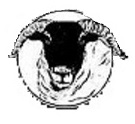
The Blackface Breed
All Blackfaces are horned, with black or black and white face and legs. The fleece should be free of black fibre and can vary from short, fine wool used for carpets and tweeds to strong coarse wool, which is sold mainly for the Italian mattress trade.
There are several distinct types within the breed. These have evolved over the years, influenced by climate, environment and grazing quality. This gives the breed the advantage of being able to produce species to suit every climatic condition. The Scottish Blackface, which are the most numerous, are sub-divided into three types.
- The Perth type, a large-framed sheep with a medium to heavy wool, is found mainly in north-east Scotland, south-west England and Northern Ireland. The larger frame produces
lambs ideal for long keep on winter forage or indoors, to finish in the spring when hogget prices tend to be on the rise. With hoggets reaching a finishing weight of 40kg plus. A Perth ram can bring size, strength and vigour to a hill flock. - The Lanark type, which is dominant in much of Scotland and areas of Ireland, is of medium size, with shorter wool than the Perth type. Over the past thirty years, a strong influence of Newton Stewart type has been introduced, the integration of Lanark and Newton Stewart bloodlines, as well as benefiting both milking ability and hardiness, has helped create a more uniform and identifiable breed.
- In the north of England, the large-framed, soft wooled Northumberland Blackface is popular and influential in breeding the North of England Mule.
Blackface History
The breed’s origin is lost in the midst of time, but undoubtedly emerged from the genetic umbrella of’ horned sheep from which also sprung the Swaledale, Rough Fell and other localised types such as the Lewis and Mayo Blackface.
Monastery records of the 12th century tell of the Dun or Blackface breed of sheep. The monks used the wool for their clothes, and also exported large amounts to Europe.
In the 16th century, King James IV of Scotland established an improved Blackface flock in Ettrick Forest. During the 17th and 18th centuries. It was known as the Linton Sheep, West Linton in Peeblesshire being the main sale for the type.
In the early 19th century, the breed was taken from Dumfriesshire and Lanarkshire and introduced into the north of Scotland, but due to the high price of cheviot wool the Blackfaces were cleared off the hills in favour of the cheviot. This continued until 1860, when the wool prices reached the same level and the farmers realised that the blackface, with its ability to survive and reproduce in adverse weather conditions, was the best suited breed to utilise hill and mountain grazing.
In the late 19th century, there was an upsurge in interest in breed improvement. Many of the farms that sold high priced tups and enthusiastically promoted the breed at that time possessed names that are still well known today.
Breed Purpose
The principal function of the breed is to utilise the hill and mountain grazing of the British Isles to best advantage, producing store lambs which are suitable for short or long keep, finishing off grass, rape, turnips or in-shed.
Off better hill grazing, many lambs are sold prime direct off their mothers at carcase weights of 15-19 kgs. The smaller hill lamb is ideal for the markets of Italy and Spain, which require carcase weights of 8-12 kgs. Blackface lamb is naturally reared, symbolising the purity and goodness of the land and has a reputation for its unrivalled sweet flavour and tenderness. Available from September onwards, it is without doubt ‘ naturally good ‘.
Of equal importance, the Blackface is at the summit of the pyramid of stratification of the British sheep industry. The hills produce a reservoir of females, which are drafted to marginal or upland farms either as ewe lambs or five or six year old ewes, where they are crossed with a Bluefaced Leicester to produce the ever popular Scotch Mule Ewe, or a Border Leicester to produce the Greyface Ewe.
Crossed with a terminal sire, the blackface ewe produces a quality prime lamb, or a store lamb for finishing.
Breed Improvement
The Breed Association supports research work on genetic selection on hill farms in Scotland and Northern England.
Its aim is to improve carcase quality, while retaining the character required for survival and efficient hill production. As well as this, there are breeders involved in both Sire Reference groups and breed improvement projects.
In 1998, the Highlands and Islands Sheep Strategy (HISS) was launched. This is a major £1.16 million investment to improve the financial viability of hill sheep producers in the Highlands and Islands by improving the quality of lambs in line with market requirements.
The major partners in the Strategy are the Blackface and North Country Cheviot Sheep Societies, the Meat and Livestock Commission, and Highlands and Islands Enterprise. HISS is part funded by SERAD and the European Commission.